April Was Designated Fair Housing Month as a Result of
It is almost our favorite time of year here at the Fair Housing Project of CVOEO- Fair Housing Month!
Each April at CVOEO's Fair Housing Project, we celebrate the 1968 passage of the Fair Housing Act with a series of public education and art events to raise awareness about housing discrimination in Vermont and the positive role that inclusive, affordable housing plays in thriving communities. To promote Fair Housing education and awareness, the Fair Housing Project facilitates a series of zoom webinars, Fair Housing workshops, and art activities, prompting participants to reflect on what Fair Housing means in their community.
Join us!
There are a variety of ways you, your community, or your organization can participate in the celebration this year, despite us being unable to meet in person. Our Fair Housing Month calendar is filling with events hosted by us and organizations across the state, including Fair Housing Friday zoom webinars, the Old North End Art Center's art camps, and HeART & Home community art project, library book and film discussions, and Fair Housing workshops.
Let us know how you, your community, or your organization would like to participate by filling out this brief form .
(Of course, we anticipate these activities will be held remotely, and when possible, outdoors with physical distancing. )
Here are some examples of the variety of ways you can join us in celebrating Fair Housing Month:
- Host an event in your community focusing on the history and impact of the Fair Housing Act, local housing needs, or the value of diversity and inclusion in housing (which we will add to our Fair Housing Month event calendar)
- Participate in the HeART & Home Community Art Project, or lead a HeART & Home Community Art activity in your community/classroom/organization
- Participate as a panelist in one of our three Fair Housing Fridays
- Invite us to do a Fair Housing workshop with your community/organization
- Start a discussion group in your organization or community (see list of books and films at https://libraries.vermont.gov/fairhousing2021 )
This year we have a new partnership with the Vermont Department of Libraries and Vermont Library Association for new activities, like book discussion groups, story walks, and more at sites all over the state. Click here to learn more!
Are you curious about our HeART & Home Community Art Project? Check out a couple of the prompts we are sharing with our project participants.
For examples of past activities and to see this year's full calendar of events (which will be posted later this month), visit www.FairHousingMonthVT.org .
If you are interested in participating in any capacity in our Fair Housing Month Celebration, please fill out this brief f o r m .
Fair Housing Month activities in Vermont are coordinated by the Fair Housing Project of CVOEO , in collaboration with Vermont Department of Libraries , Vermont Library Association , ONE Arts Center , Vermont Legal Aid , Vermont Human Rights Commission , VT Department of Housing and Community Development , and other partners. This program is supported by a Department of Housing and Urban Development (HUD) Fair Housing Initiatives Program grant and supported by the Institute of Museum and Library Services, a federal agency, through the Library Service and Technology Act as administered by the Vermont Department of Libraries.
Fair Housing is the right to equal opportunity in housing choice and the right to rent, buy, finance, and live in a home free from discrimination or harassment. The federal Fair Housing Act prohibits discrimination concerning the sale, rental, and financing of housing based on race , color , religion , national origin , sex , and as amended, disability and family status . This also covers harassment, including sexual harassment.
Vermont has additional protections based on age , marital status , sexual orientation , gender identity , receipt of public assistance , being a victim of domestic violence, sexual assault, or stalking , and denial of development permitting based on the income of prospective residents.
To learn more about your Fair Housing rights and responsibilities, visit www.cvoeo.org/fhp and see www.fairhousingmonthvt.org for April fair Housing Month details. Contact us at fhp@cvoeo.org.
VT Governor Phil Scott's Proclamation of April as Fair Housing Month and marking the celebration of the 50th anniversary of the Federal Fair Housing Act.
[pdf-embedder url="http://www.thrivingcommunitiesvt.org/wp-content/uploads/2018/04/Gobernatorial_FH-Proclamation_2018.pdf" title="Gobernatorial_FH Proclamation_2018″]
Burlington Mayoral Proclamation of April, 2018 as Fair Housing Month in Burlington, VT and Burlington celebrates April, 2018 as the 50th Anniversary of the Federal Fair Housing Act.
[pdf-embedder url="http://www.thrivingcommunitiesvt.org/wp-content/uploads/2018/04/BurlingtonMayor_FH-Proclamation_2018.pdf" title="BurlingtonMayor_FH Proclamation_2018″]
 Getting a head start on April in March –
Getting a head start on April in March –
Note: All the content below in this post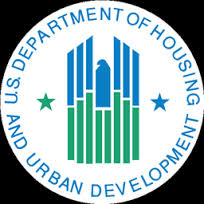
In April, we come together as a community and a nation to celebrate the anniversary of the passing of the Fair Housing Act and recommit to that goal which inspired us in the aftermath of Rev. Dr. Martin Luther King Jr's assassination in 1968: to eliminate housing discrimination and create equal opportunity in every community.
Fundamentally, fair housing means that every person can live free. This means that our communities are open and welcoming, free from housing discrimination and hostility. But this also means that each one of us, regardless of race, color, religion, national origin, sex, familial status, and disability, has access to neighborhoods of opportunity, where our children can attend quality schools, our environment allows us to be healthy, and [for us to grow] opportunities and self-sufficiency.
…commitment to fair housing is a living commitment, one that reflects the needs of America today and prepares us for a future of true integration.
History of Fair Housing –
On April 11, 1968, President Lyndon Johnson signed the Civil Rights Act of 1968, which was meant as a follow-up to the Civil Rights Act of 1964. The 1968 act expanded on previous acts and prohibited discrimination concerning the sale, rental, and financing of housing based on race, religion, national origin, sex, (and as amended) handicap and family status. Title VIII of the Act is also known as the Fair Housing Act (of 1968).
The enactment of the federal Fair Housing Act on April 11, 1968 came only after a long and difficult journey. From 1966-1967, Congress regularly considered the fair housing bill, but failed to garner a strong enough majority for its passage. However, when the Rev. Dr. Martin Luther King, Jr. was assassinated on April 4, 1968, President Lyndon Johnson utilized this national tragedy to urge for the bill's speedy Congressional approval. Since the 1966 open housing marches in Chicago, Dr. King's name had been closely associated with the fair housing legislation. President Johnson viewed the Act as a fitting memorial to the man's life work, and wished to have the Act passed prior to Dr. King's funeral in Atlanta.
Another significant issue during this time period was the growing casualty list from Vietnam. The deaths in Vietnam fell heaviest upon young, poor African-American and Hispanic infantrymen. However, on the home front, these men's families could not purchase or rent homes in certain residential developments on account of their race or national origin. Specialized organizations like the NAACP, the GI Forum and the National Committee Against Discrimination In Housing lobbied hard for the Senate to pass the Fair Housing Act and remedy this inequity. Senators Edward Brooke and Edward Kennedy of Massachusetts argued deeply for the passage of this legislation. In particular, Senator Brooke, the first African-American ever to be elected to the Senate by popular vote, spoke personally of his return from World War II and inability to provide a home of his choice for his new family because of his race.
With the cities rioting after Dr. King's assassination, and destruction mounting in every part of the United States, the words of President Johnson and Congressional leaders rang the Bell of Reason for the House of Representatives, who subsequently passed the Fair Housing Act. Without debate, the Senate followed the House in its passage of the Act, which President Johnson then signed into law.
The power to appoint the first officials administering the Act fell upon President Johnson's successor, Richard Nixon. President Nixon tapped then Governor of Michigan, George Romney, for the post of Secretary of Housing and Urban Development. While serving as Governor, Secretary Romney had successfully campaigned for ratification of a state constitutional provision that prohibited discrimination in housing. President Nixon also appointed Samuel Simmons as the first Assistant Secretary for Equal Housing Opportunity.
When April 1969 arrived, HUD could not wait to celebrate the Act's 1st Anniversary. Within that inaugural year, HUD completed the Title VIII Field Operations Handbook, and instituted a formalized complaint process. In truly festive fashion, HUD hosted a gala event in the Grand Ballroom of New York's Plaza Hotel. From across the nation, advocates and politicians shared in this marvelous evening, including one of the organizations that started it all — the National Committee Against Discrimination In Housing.
In subsequent years, the tradition of celebrating Fair Housing Month grew larger and larger. Governors began to issue proclamations that designated April as "Fair Housing Month," and schools across the country sponsored poster and essay contests that focused upon fair housing issues. Regional winners from these contests often enjoyed trips to Washington, DC for events with HUD and their Congressional representatives.
Under former Secretaries James T. Lynn and Carla Hills, with the cooperation of the National Association of Homebuilders, National Association of Realtors, and the American Advertising Council these groups adopted fair housing as their theme and provided "free" billboard space throughout the nation. These large 20-foot by 14-foot billboards placed the fair housing message in neighborhoods, industrial centers, agrarian regions and urban cores. Every region also had its own celebrations, meetings, dinners, contests and radio-television shows that featured HUD, state and private fair housing experts and officials. These celebrations continue the spirit behind the original passage of the Act, and are remembered fondly by those who were there from the beginning.
U.S. Department of Housing and Urban Development
It wasn't the failure of "forced busing" that led to current racial disparities in school achievement outcomes. The problem, rather, is that the nation's schools have become more segregated over the last three decades, as integration dropped from the agenda of education policy-makers.
So wrote a Syracuse University education professor, George Theoharis, in an interesting piece in the Washington Post Sunday. 
Two startling observations derive from his home town — which happens to be in our neck of the woods.
He notes the enormous disparities in programs, and outcomes, between a middle school with an 85 percent black and Latino student body and another middle school, 10 miles away, that's 88 percent white. And he points out that in 1989, the city's schools were about 60 percent white and 20 percent black/Latino, and that now, the district is 28 percent white, 55 percent black/Latino.
Theoharis goes on to discuss how a renewed emphasis on desegregation in educational policy could provide remedies: Redesigning school districts, for example, and putting them together "like pie pieces, so they cut across urban, suburban and even rural spaces"; or creating magnet schools; or providing incentives to school districts to desegregate.
(Note: Magnet schools were the Burlington School District's remedy for socioeconomic achievement gaps.)
But Theoharis never delves into the heart of the matter: residential segregation. This has grown worse in many cities since 2000, with an increase in the number of high-poverty neighborhoods, as we noted in an earlier blog post citing "The Architecture of Segregation," a paper that detailed the demographic trends. In Syracuse since 2000, according to that paper, "the number of high-poverty tracts more than doubled, rising from twelve to thirty… As a result, Syracuse now has the highest level of poverty concentration among blacks and Hispanics of the one hundred largest metropolitan areas," as shown in this table:
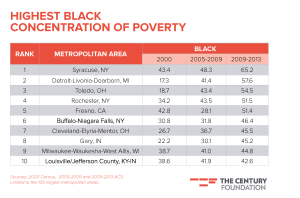
The takeaway is that addressing residential segregation iskey to addressing school segregation. Another analysis of school segregation and racial performance disparities, by the Economic Policy Institute's Richard Rothstein, put it like this:
"Education analysts frequently wonder why a black–white achievement gap remains, even when individual poverty and family characteristics are similar. Partly it's because of greater (and multigenerational) segregation of black children into neighborhoods of high poverty, few employment opportunities, and frequent violence….
"It is inconceivable to think that education as a civil rights issue can be addressed without addressing residential segregation … Housing policy is school policy; equality of education relies upon eliminating the exclusionary zoning ordinances of white suburbs and subsidizing dispersed housing in those suburbs for low-income African Americans now trapped in central cities."
That's what affirmatively furthering fair housing is all about, right? But you already knew that.
Fair Housing Law cognoscenti will be happy to learn of new journal article by Robert G. Schwemm, acknowledged to be a principal academic authority in these matters. In a Columbia Law Review sidebar, Schwemm takes on the recent U.S. Supreme Court ruling on disparate impact and sorts through the ramifications, "What's new and what's not."
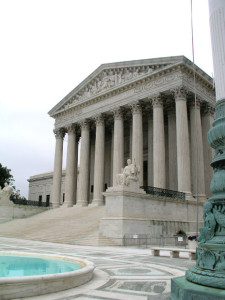
Even for non-cognoscenti this article can be useful, given that it's a fairly breezy (for a law journal) way of catching up with fair housing developments.
The court's opinion – which essentially upheld the longstanding theory that discrimination is legally actionable by virtue of its effect, not merely intent, was celebrated by fair housing advocates all over the country. The impact on Vermont remains to be seen, however, because disparate-impact arguments typically rely on statistics, and Vermont communities are so small that statistics are not always meaningful.
Still, Schwemm 's article makes several points worth Vermonters' notice, among them:
–the established practices, since the mid '70s, of using disparate impact to challenge "exclusionary zoning and other land-use restrictions by local governments that blocked or limited housing proposals of particular value to racial minorities or persons with disabilities."
–the additional protected classes that Vermont (and many other states) added in their own fair housing laws are specifically preserved under the federal Fair Housing Act. Those additional categories in Vermont include receipt of public assistance (e.g. Section 8), sexual orientation and gender identity. The implication is that, because of the Supreme Court decision, disparate-impact claims could be made successfully for people in these, state-specific categories as well. Assuming, that is, that the plaintiff could get the necessary numbers in order.
Today is HUD's 50th birthday – that is, it was 50 years ago today that President Johnson signed the legislation adding a Department of Housing and Urban Development to the Cabinet. Here's a photo of LBJ presenting a ceremonial pen to Robert C. Weaver, who later became HUD's first leader.
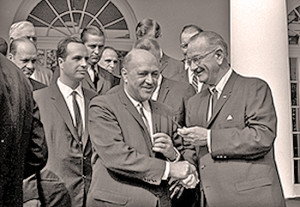
Of course, we'll all mark this anniversary in our own ways. If you want to join HUD's own celebration of "50 years of creating opportunity," complete with video testimonials and public housing success stories, click here, for a mere chronology, here.
We'd be remiss if we didn't acknowledge that HUD has come in for plenty of criticism over the last five decades for "straying from its mission" to promote residential integration. For a recent example that appeared as an op-ed in the Baltimore Sun after the recent turmoil in that city, click here. For a critical history of the department published by ProPublica in 2012, click here.
A couple of historical notes: Weaver, who held three Harvard degrees and had served as a New Deal presidential advisor, was the first African American Cabinet secretary. Romney, who served as secretary during Nixon's first term, was such an ardent champion of affirmatively furthering fair housing that he ran afoul of the White House and was forced out.
Three years ago a reporter could write:
"ProPublica could find only two occasions since Romney's tenure in which the department withheld money from communities for violating the Fair Housing Act. In several instances, records show, HUD has sent grants to communities even after they've been found by courts to have promoted segregated housing or been sued by the U.S. Department of Justice."
HUD has since stepped up its efforts, and the new AFFH rule is widely seen as a harbinger of more vigorous enforcement of the Fair Housing Act.
Here's a video clip of LBJ's remarks 50 years ago, including this nugget: "Our cities and our new urban age must not be symbols of a sordid society."
It's not every day that we can praise the New York Times editorial board for following in Thriving Communities' wake. Saturday's editorial, which borrows its headline, "The Architecture of Segregation," from a study we posted about last month. The editorial, while noting this two summer's "positive" developments – the Supreme Court's disparate impact decision and HUD's AFFH rule – rightly takes federal officials to task for failing, over many years, to enforce the Fair Housing Act. And the editorial invokes Walter Mondale's comments at the HUD conference last week about how the act's intent is "not fulfilled" by exclusionary land-use planning.

While government deserves a good share of the blame for the present state of residential racial segregation, there are those in the community of fair housing advocates who contend that the real estate industry has been at fault, too. How else to account for the fact that upper-middle-income black families don't have comparable access to the neighborhoods where their upper-middle-income white family peers live.
Indeed, one factor that may have contributed to segregated patterns is the choice of many whites to opt out of integrated communities, as Stacy Seicshnaydre pointed out in a law journal article last year, "The Fair Housing Choice Myth." And one way to address that, Seicshnaydre argued, is to defund exclusion — as application of the AFFH rule promises to do, at least in theory.
Meanwhile, HUD conferees were reminded last week, redlining is still with us, and new cases are in the pipeline.
Here's Fritz Mondale, former VP and co-sponsor of the Fair Housing Act, speaking yesterday about what it took to get the bill through Congress. Among other things, it required support from "Lincoln Republicans" and a nudge from President Johnson.
The venue was HUD's National Fair Housing Conference, in Washington, for which Mondale was the keynoter.
//
And here's Richard Rothstein, of the Economic Policy Institute, debunking the national myth of "de facto segregation" — and explaining how residential racial segregation has been a result of conscious public policy on the part of federal, state and local governments.
http://
Monday's civil rights hearing covered a lot of ground on housing discrimination, but it never got around to advertising. Maybe that's because illegal ads aren't as pervasive as they used to be. Signs like this hard seldom seen nowadays:
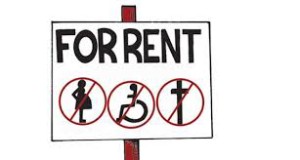
The newspaper staffers who oversee classified ads are generally savvy – they've been brow-beaten by fair housing activists enough over the years to have a pretty good idea what passes muster and what doesn't. Then again, how much real estate advertising are newspapers getting these days, anyway? Not as much as they used to, sadly.
The most popular advertising venue that lacks editorial oversight, of course, is Craigslist. And that's what the Fair Housing Project devotes most of its monitoring time to, in its capacity of advertising watchdog.
Craigslist, to its credit, puts a little blurb in each of the entries, "please flag discriminatory housing ads" with a link to a summary of what's prohibited under the federal Fair Housing Act. Vermont's Craigslist does not provide any info about Vermont-specific discrimination, however. "Receipt of public assistance" is a protected class in Vermont, which means ads can't say "No Section 8."
Very few do, though, even on unfiltered Craigslist. Over the last five months, browsing Vermont rental ads on Craigslist several times a week, we've found 30 ads with one or two violations (or probable violations – we're not an enforcing agency, after all).
About two-thirds of the violations have pertained to familial status – a federally protected category. That means presence of kids. That is, the ads appear to discriminate against families with children.
Much of the discriminatory language might be characterized as subtle. Just about everybody, even the proverbial small-time landlord, knows better than to say "no children." Instead, they say things like, "best for singles or couples" or "single occupant" or "college students only."
Roughly one-third of the violations pertain to receipt of public assistance. Here again, the language is less than direct. "Professionals only" … other units "occupied by executives, business owners" … "located in a quiet, professional neighborhood."
The great majority of real estate ads on Craigslist are fine, at least in fair housing terms. Most advertisers, intentionally or not, abide by this useful guideline for what to put in the ad: Describe the property, not who you want to live there.
Amid all the overarching attention to housing segregation and inclusiveness prompted by HUD's newly released AFFH rule, we shouldn't lose sight of housing discrimination at the granular, or individual level. It's still very much with us, in Vermont and everywhere else. What's more, there's a good deal of housing discrimination that goes unreported, as a cursory look at Vermont's statistics makes clear.
First, the national picture: HUD does an annual report toting up housing discrimination complaints based on seven protected categories in the Fair Housing Act: race, color, national origin, religion, sex, disability, familial status. In the last fiscal year for which data are available, total complaints to HUD and affiliated agencies totaled 8,368, of which 53 percent were based on disability, 28 percent on race, 14 percent on familial status (presence of minor children) and 12 percent on national origin.
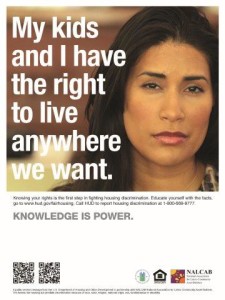
Now consider the complaints filed with the Vermont Human Rights Commission. According to the commission's most recent annual report, there were 41 housing discrimination complaints in Fiscal Year 2014, of which 19 were based on disability, 4 on race/color, 4 on "minor children," and 1 on national origin.
The numbers in Vermont are pretty low, and the discriminatory profile is a bit different from the that for the nation as a whole. Disability is the major source of complaints here, as elsewhere, but in Vermont just 10 percent of the complaints pertained to race. Granted, Vermont is 95 percent white, but the number seems low for two reasons.
For one thing, hundreds of refugees are arriving in Vermont every year. It seems implausible that they confront no discrimination based in the real-estate rental market based on race, religion or national origin.
For another thing, Vermont Legal Aid's periodic tests of Vermont's rental markets show much higher incidences of discrimination than are reflected in the complaint statistics.
In 2012-13, VLA conducted more than 200 tests, using control testers and subject testers of assorted races and national origins expressing interest in renting apartments. "Forty-four percent of the tests conducted either demonstrated overt discrimination against the subject tester or otherwise showed preferential treatment toward the control tester," the VLA's report concluded. "(T)here were significant rates of disparate treatment against the subject testers in 46 percent of the national origin tests, 45 percent of the familial status test, 36 percent of the African American race/color tests, and 22 percent of the disability tests."
So, why aren't more fair housing complaints filed in Vermont? Perhaps because many tenants don't know their rights, or because they might fear retaliation. As it happens, protection from retaliation is one the rights they might not be aware of.
April Was Designated Fair Housing Month as a Result of
Source: http://www.thrivingcommunitiesvt.org/tag/fair-housing-act/
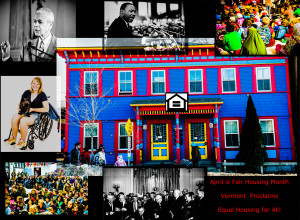 Getting a head start on April in March –
Getting a head start on April in March –
0 Response to "April Was Designated Fair Housing Month as a Result of"
Post a Comment